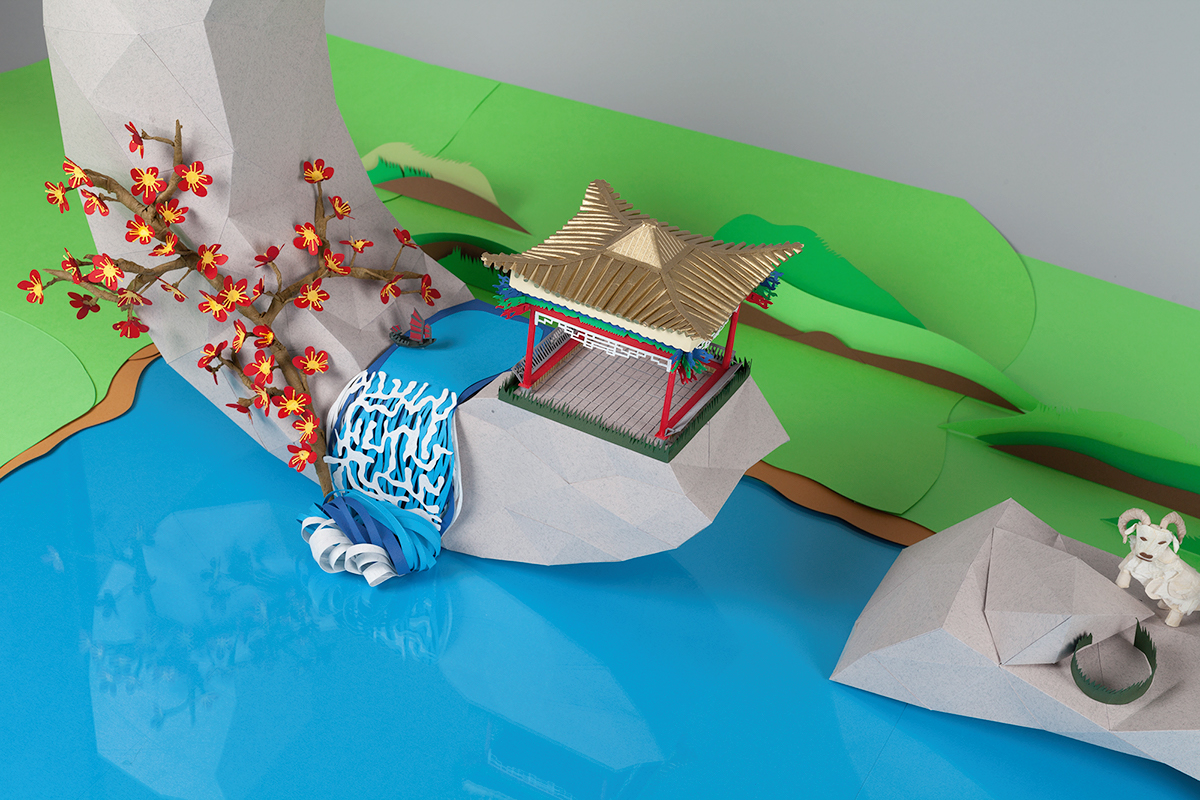
Tiny little tiny drop, put that there, take this here, and I am firmly pressing down and holding for about maybe ten seconds. You have to go a little bit fast here, so that these things do…. I am just going to use a tiny little dot and now I going to close up to do the rest of this. You have to use a very small amount of glue, and this is the only thing that adults sometimes can’t do and kids can. Now the trick here is that you have to… And I have a little exacto blade to pick this up like this. This looks like it might be wood glue, but it’s still Elmer’s wood glue so I just use Elmer’s. This is my presser to press the glue that is rounded with the sharpie here. So now I am going to place this here and have all my little elements sticking on here waiting. This is nice you can have a lot of movement and there is a nice little resistance in these puppets so it’s easy to move them. This is just glued from here and here and these little edges and this hand is just sliding in like a little pocket.
How to do stop motion animation on paper how to#
Ok, so I am going to make that kind of hand… Just kind of change it up and show you how to make cause it’s pretty obvious. So this is a piece of paper… This has a hole punched in it just like this does and there is a tiny bit of glue that connects this with this. Now I’ve cut this guy out and I will show you a few different hinges that I have made.

So now I am going to make the camera a little more close up when I finish this. And tooth is kind of cool, but if you are going to do close ups you sometimes don’t want people to see the paper, depends on what your aesthetic is. I am using Bristle board by the way, which is really great because it has no tooth. Looking for more post-production tips and tricks? Check out these articles.If you are doing these cut outs with sound cut outs, you can use just paper but it’s sometimes nice if you can to mount them on paper. In addition to these ideas, you can also use Posterize Time to create flashbacks, dream sequences, or even a drunken or drugged POV shot. Take a look at the difference between 8 fps and 24 fps. Once I’ve placed the graphic on the timeline, I’ll add Posterize Time, and set it to 8 fps. I’ve specifically picked one that has a “fluid” look. For this example, I’ve gone into Premiere Pro’s Essential Graphics panel and found a motion graphics template. To apply this look to a large number of clips, I can simply apply all of the effects to an adjustment layer, instead of individual shots.Īpply Posterize Time to your motion graphics to quickly change the look of your design. For example, I’ll set Posterize Time anywhere between 8-12 fps, and then add the Lumetri effect to desaturate, lower the contrast, and add a vignette. Use this effect in conjunction with other effects to create a very realistic old film look. Ī great use of the Posterize Time effect is helping simulate the slow frame rates of older cameras. For example, shots with little to no motion blur work best.īut what else can I accomplish with this effect? Well. The composition, movement, and frame rate of the original shot will certainly play into the final look. While 10 fps will give me a nice, blocky look, I can always test out different rates for different results.

To recreate this look, I simply need to set the frame rate of my existing clip to the same fps. As I mentioned before, the blocky animation shot I created in the previous tutorial was shot and edited at 10 fps. How can we make this happen on an existing video clip? It’s actually quite simple.Ĭreating this look is really as simple as applying a default effect in Adobe Premiere Pro. But, let’s say that we’re working on a project that’s already shot, and we want to achieve this same blocky animation look. In the tutorial above, I focus on a few basic production techniques, including camera position and angle, lighting, and editing an image sequence. Yeah, all of this work for 10 seconds of video.Īs I’m sure you’re already aware, it takes a bit of time to set up, shoot, and edit a proper stop motion shot. To achieve the popular blocky-style look, I shot 50 images to create a 5-second animation at 10 fps. The shot consists of a crumpled paper moving onscreen, uncrumpling, recrumpling, and then moving back off screen. In that video, I show how to animate a basic paper crumple effect. In this quick guide, we’ll show you how.Ī while back, I produced a tutorial showing users how to get started creating stop motion videos.

Shooting a stop-motion project is difficult and time-consuming.


 0 kommentar(er)
0 kommentar(er)
